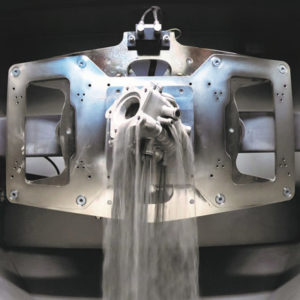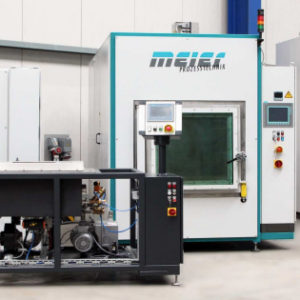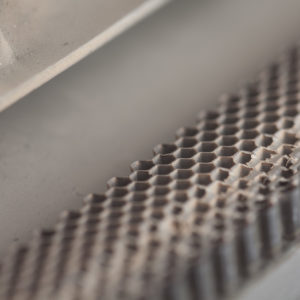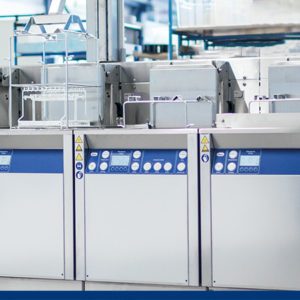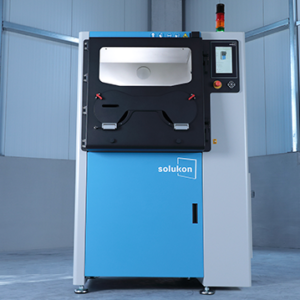As you may have read, Turbex has recently joined forces with Solukon, a pioneer and market leader of automated powder removal. In order to grow and keep bringing the most effective solutions for our clients, we work with true industry innovators, like Solukon.
Solukon understands that in order to be a pioneer in the field of post-processing, they need to account for every part of the process chain in Additive Manufacturing (AM). In order to fulfil this goal, they have recently launched the Solukon Digital Factory Tool – an interface management concept to fit Solukon’s depowdering systems into a holistic AM process chain. This is a crucial step forward in realising a fully-integrated automated AM solution that’s so desperately needed in the industry.
Why is automation so crucial in Additive Manufacturing?
AM has grown exponentially in recent years. However, connecting the different parts of the process chain (for instance, the printing job, depowdering or removal of support structures) is still largely ignored by leading OEMs and service providers.
Solukon believes that by connecting the whole process chain, a fully automated AM could one day be a reality. However, in order to do this, better solutions need to be implemented for depowdering.
Solukon’s unique approach to depowdering
With a range of difficulties – including risk of explosion, occupational health, labour costs, powder recovery, cleaning quality and process repeatability – depowdering is often considered the weak leak in the AM process.
Solukon uses its unique depowdering technology SPR® (Smart Powder Recuperation) to remove loose powder from metal laser melted parts within a sealed process chamber, using adjustable vibration and automated two-axis part rotation.
Thanks to the programmable rotation of the build-plate in two axes, unfused metal build material is completely removed from complex channels and geometries. For clients, this means a significant increase in efficiency, security and quality at a reduced cost.
Why is the Solukon Digital Factory Tool such a game-changer?
In 2018 Solukon worked with Siemens to develop SiDAM software, which is based on a digital twin and a flow simulation algorithm. This intelligent software ensured complex parts, such as heat exchangers, were moved along intricate inner channels and emptied in a safe way. Depowdering results have since been reproducible, modifiable and safely automatable. As a result of this innovation, the SiDAM project of Solukon and Siemens received the TCT award 2019 in the post processing category.
Since then, Solukon has adjusted its sensor concept and launched an interface management concept in order to fit the depowdering process into a holistic digital production environment. This will increase efficiency and ensure continuous quality control.
Why is the Solukon Digital Factory Tool such a game-changer?
The Solukon Digital Factory Tool allows an easy integration of automated powder removal into an overall digital AM process. Its features include:
Production control
Collecting and managing machine data around operating time and shutdowns is an essential part of any AM automation. Overall equipment effectiveness (OEE) for further production planning relies on the processing of this data and so Solukon knew this was an essential part of their new interface.
Solukon understood that for planning, the operator is usually using apps, wherein data is collated and summarised in dashboards. Afterwards the operator may consider a planning software for evaluation.
The Solukon OPC-UA interface allows both access to machine data and remote control. As well as this, the Solukon Digital Factory Tool enables the operator to integrate all information into the dashboard of the machinery app.
Data and parameters referring to powder removal programs, such as running time and batch number, can easily be assigned via the network. Regarding the depowdering process the OPC-UA interface enables the operator to start, monitor and modify the depowdering program as desired. What’s more, machine state and process progress are accessible in real time.
Maintenance management
Sensitive machine components and processes, which affect the lifetime of the machine, are closely monitored by Solukon’s new sensor system. This means the operator can recognise unwanted changes in consumption of inert gas, compressed air, chamber atmosphere or energy to get an overview about the performance of the individual machine components.
Furthermore, the system will immediately inform the operator when maintenance is required or when to procure wear parts. Upon request, Solukon sets up an interface for remote maintenance and diagnosis.
Integration of automation
The integration of downstream processes plays an increasingly important role in AM. Flagship projects like HyProCell issue an outlook on how automated AM production works.
At HyProCell, Solukon has set the bar in automation integration. The Solukon system SFM-AT800 is constantly communicating with a control center while being loaded by a robot. For this purpose, the SFM-AT800 has been equipped with a special loading door and an automatic clamping system.
Process validation / quality management
The extended quality feature is a key element of the Solukon Digital Factory Tool. After all, certification is a huge but essential challenge for manufacturers in the medical and aerospace industry. Each step of production has to be clearly reproducible, and the more process data that’s recorded and logged, the easier the certification will be.
The Solukon Digital Factory Tool provides a sensor package to record relevant conditions in the process chamber – such as residual oxygen, humidity, pressure, temperature and frequency of the vibrator – in a protocol file for quality assurance. Further effective evaluation of the recorded data helps to validate the process in an overall quality certificate and simplify the process optimisation.
Furthermore, the operator may set limits to sensible values in advance so that deviations are acknowledged and quality defects avoided. In fact, all information referring to the depowdering program itself is recorded automatically.
To create a certification document for each project, the user can fill out a large and individual composable input mask and then collect data referring to this build job in a flexible dialog box. This could include type, batch and used material. The user can then download the final protocol as a PDF, CSV or XML file.
In summary: what does Solukon’s Digital Factory Tool do?
- It raises quality management to the highest level.
- It provides continuous documentation and real time monitoring.
- Through process validation, its users can achieve a faster, more accurate and easier certification.
- The complete process step is fully recorded and can be resubmitted for proof of quality.
- Problems and quality deficiencies can easily be identified in time and their cause revealed.
To find out more about Solukon’s depowdering systems, get in touch today.


